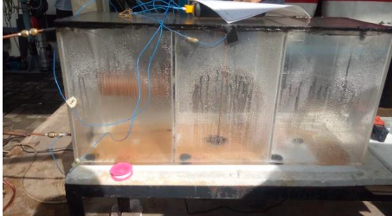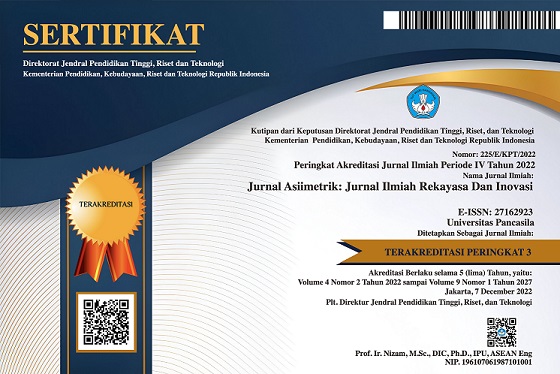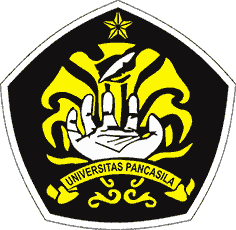Pengembangan Alat Desalinasi Air Laut dengan Teknologi Thermal Energy Storage
Development of Seawater Desalination Equipment with Technology Thermal Energy Storage
Abstract views: 688 | pdf downloads: 976
Abstract
The need for clean water in household life is very important because humans cannot live without it. The composition of seawater consists of 96.5% pure water and 3.5% other materials, namely salts, dissolved gases, and others. Indonesia is one of the countries that has the second-longest coastline in the world, so the potential for utilizing sea water is very large, one of which can be through the desalination process. Distillation itself is distillation, and its by-product is salt when seawater is heated using a heat energy source with a concentrated solar power (CSP) system. Based on research that has been done previously, the tool is a lab-scale seawater desalination device, but the process of making a lab-scale seawater desalination tool is not optimal. Then design the construction of a lab-scale seawater desalination device with the Multi Stage Flash (MSF) type, and the aim is to determine the performance and functionality of the MSF-type lab-scale seawater desalination device. The results show that the results of the coil heat exchanger development obtained an inlet temperature of 85.9°C and an outlet temperature of 67.8°C, and the room temperature in the chamber can be maintained at a temperature of 68.9°C. As for the components being developed, such as sea water pumps, hoses, tees, and sprayers, a sea water debit of 53.78 liters per hour has been obtained.
Downloads
References
Abdulloh, S.H. (2015) Desalinasi Air dengan Memanfaatkan Energi Terbarukan. Thesis. Institut Teknologi Bandung.
Adhitya, D.C. dkk. (2021) ‘Thermal Enhancement for Paraffinic Thermal Energy Storage by Adding Volcanic Ash’, VANOS: Journal of Mechanical Engineering Education, 6(1), hal. 77–88.
Astawa, K., Sucipta, M. dan Negara, I.P.G.A. (2011) ‘Analisa Performansi Destilasi Air Laut Tenaga Surya Menggunakan Penyerap Radiasi Surya Tipe Bergelombang Berbahan Dasar Beton’, Jurnal Energi Dan Manufaktur, 5(1), hal. 7–13.
Dailami, D. dkk. (2012) ‘Karakteristik Perpindahan Panas Peleburan Parafin-Al2O3 Sebagai Material Penyimpan Panas’, in Prosiding Seminar Nasional Energi Terbarukan Dan Produksi Bersih 2012. Prosiding Seminar Nasional Energi Terbarukan Dan Produksi Bersih 2012, Bandar Lampung: Universitas Lampung.
Hanna, N.L. (2016) ‘Kelayakan Teknologi Desalinasi Sebagai Alternatif Penyediaan Air Minum Kota Surabaya (Studi Kasus: 50 Liter per detik)’, Jurnal Teknik ITS, 5(2), hal. D47–D52.
Herdyana, R.C. (2021) Proses Manufaktur Alat Desalinasi Air Laut Skala Lab Tipe Multi Stage Flash Menggunakan Phase Change Material Berbasis Concentrated Solar Panel. Skripsi. Universitas Pancasila [Cetak].
Krisdiarto, A.W., Ferhat, A. dan Mohammad (2020) ‘Penyediaan Air Bagi Masyarakat Pesisir Terdampak Kekeringan dengan Teknologi Desalinasi Air Laut Sederhana’, DIKEMAS (Jurnal Pengabdian Kepada Masyarakat), 4(2), hal. 25–31.
Nannarone, A., Toro, C. dan Enrico, S. (2017) ‘Multi-Stage Flash Desalination Process: Modeling and Simulation’, in Proceedings of ECOS 2017. 30th International Conference Efficiency Cost, Optimization Simulation Environmental Impact Energy System, San Diego California, hal. 1–12.
Patil, R.K., Shende, B.W. dan Ghosh, P.K. (1982) ‘Designing a Helical-Coil Heat Exchanger’, Chemical Engineering, 13, hal. 85–88.
Prastuti, O.P. (2017) ‘Pengaruh Komposisi Air Laut dan Pasir Laut Sebagai Sumber Energi Listrik’, Jurnal Teknik Kimia dan Lingkungan, 1(1), hal. 35–41.
Rahmalina, D. dkk. (2022) ‘Rancang Bangun Alat Desalinasi Air Laut Skala Lab Tipe Multi Stage Flash’, Otopro: Journal of Mechanical Engineering and Applications, 17(2), hal. 48–56.
Subekti, S. (2012) ‘Studi Identifikasi Kebutuhan Dan Potensi Air Baku Air Minum Kabupaten Pasuruan’, Majalah Ilmiah Momentum, 8(2), hal. 43–51.
Tian, Y. dan Zhao, C.Y. (2013) ‘A review of solar collectors and thermal energy storage in solar thermal applications’, Applied Energy, 104, hal. 538–553.
Winata, N.A. (2015) ‘Teknologi Membran untuk Purifikasi Air’, Jurnal Membran, 1(3), hal. 1–9.


























